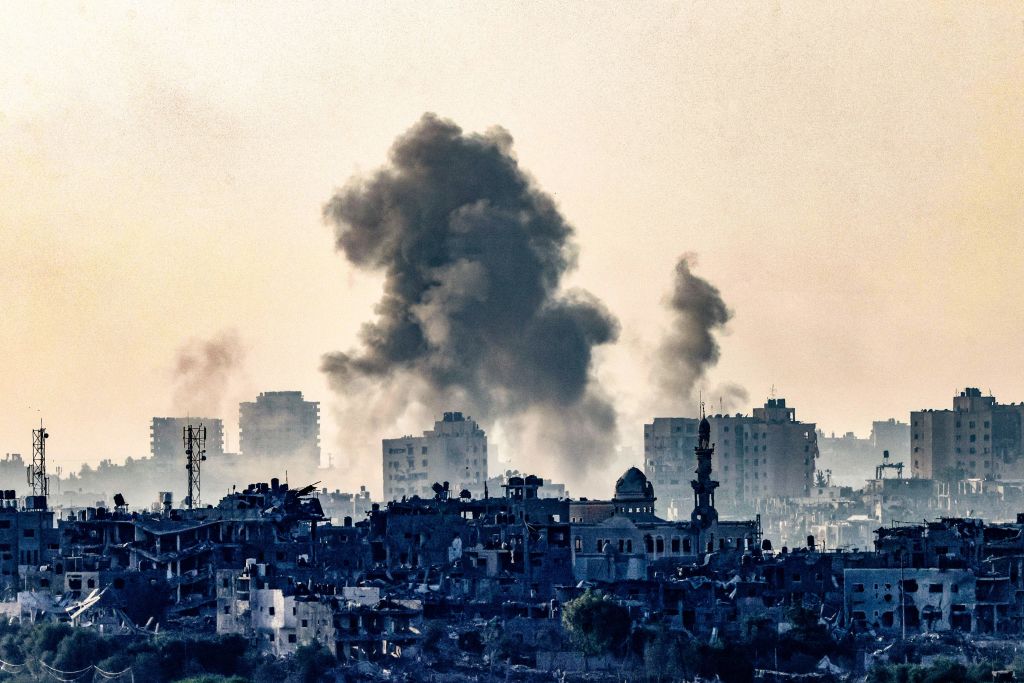Israel said its tanks had “encircled” Gaza City as this went to press, the ground offensive being stepped up after a tentative beginning — but there’s been nothing tentative about Israel’s bombings from the air. Here’s a report of one incident: at 4:30 p.m. on October 10, an explosion collapsed a six-story building in Sheikh Radwan, a district of Gaza City, killing, it was said, at least forty civilians. A man named Mahmoud Ashour had to dig through the rubble with his bare hands to find members of his family. Buried there were his daughter and her four children, a girl aged eight and three boys of six, two, and six months, all killed. They had fled there thinking it would be safer than other parts of Gaza. But, he said: “I couldn’t protect them. I have no trace left of my daughter.” Another man, Fawzi Naffar, lost nineteen of his family, including his wife, children and grandchildren. He could find only the remains of his daughter-in-law and his “son’s shoulder.”
This account is from Amnesty International, and they have no doubt this was an air strike, not a misfired rocket. They discovered that a member of Hamas was living in the building, though he wasn’t there at the time. Amnesty’s report says “membership in a political group” shouldn’t be enough to kill someone over, and if there were a Hamas fighter or commander there, it didn’t justify destroying the whole building. “This was an indiscriminate attack…and must be investigated as a war crime.” The Israeli Defense Forces told me Amnesty’s accusation rested on “the assumption that intelligence regarding the military use of a particular structure does not exist unless revealed.” The statement they sent gave no hint why they had targeted the apartment block — if this was an Israeli airstrike — but it accused Hamas of routinely putting military assets in densely populated areas. “The IDF regrets any harm caused to civilians.”
Whatever the facts of this one terrible incident, Israel is killing large numbers of unarmed men, women and children as it tries to destroy Hamas. This is because Hamas is a guerrilla army, fighting from among the people, and is not going to oblige the Israeli Air Force by gathering out in the open to be vaporized cleanly. The question of what constitutes a “proportionate response” in any given bombing is acutely difficult to answer: one Hamas fighter for one civilian? For ten? A hundred?
Professor Michael Walzer shies away from numerical formulas. He wrote perhaps the most influential modern work on the morality of armed conflict, Just and Unjust Wars. On the phone from Princeton, he cites the example of American and British bombers attacking a German tank factory in World War Two, knowing that 100 civilians living in the streets nearby will die. The tank factory is only one of thirty-three — so is it worth killing those noncombatants to stop such a small fraction of German tank production? If those tanks improve the chances of Nazi victory even slightly, you might think you could kill 1,000 civilians. He tells me: “You can play with the numbers and come to any resolution you want.” Instead, Walzer prefers an emphasis on “taking the time to aim carefully.” But if there were a bomb factory under the Sheikh Radwan apartment block, that could justify a strike, even at the cost of many innocent lives. And he says: “Hamas has never shown any concern for the wellbeing of the Gaza people. Never… Hamas deliberately puts civilians at risk because the more civilians Israel kills, the more likely Israel will lose the political war, which is as important as the military war.” Unexpectedly, perhaps, Walzer also argues that it would be morally wrong to bomb a tower block to kill a Hamas commander living there. You can attack soldiers in battle, he says; you can attack them if they’re resting at their base, but you can’t when they’re at home. That applies to the Hamas military leadership. “When they’re with their families, they are civilian at that moment.”
Walzer has been asked to pronounce on the morality of pretty much every one of America’s wars since he published his famous book in the 1970s, and many others besides. In Gaza, he wants to see “a war fought within the moral rules” — from a purely moral point of view, he considers it better to use infantry rather than airstrikes: the targeting can be more careful, though of course you risk more losses of your own. He thinks the “awfulness” of the Hamas attack on October 7 should not lead the IDF to blur the line between combatants and noncombatants. “The principle does not change even if you’re fighting against a heinous enemy.” He is worried about the angry rhetoric used by the Israeli prime minister, Benjamin Netanyahu, and some in the Israeli cabinet. Isr el’s aim should be “the defeat of Hamas and nothing more.” Gaza should be “a war of justice… not a war of vengeance.”
The language is slightly different but American officials have sent the same message. The secretary of defense, Lloyd Austin, told ABC News on October 22 that he had spoken to the Israelis and “encouraged them to conduct their operations in accordance with the law of war.” That meant allowing humanitarian aid into Gaza and providing safe corridors for civilians to leave the battle- field. Everyone knew the ground offensive would be an extremely difficult fight for Israel, Austin said: slow, grinding, full of IEDs and booby traps. It later emerged that the US had sent a Marine Corps general and a team of advisors to tell Israeli commanders about lessons learned from Iraq, especially in the battles for Mosul and Fallujah. The Pentagon told reporters the team conveyed “just how complicated urban warfare can be.”
Elliot Ackerman was in Fallujah as a young Marine Corps officer. I was a reporter “embedded” with his battalion. Ackerman, now a celebrated novelist, reminds me that most Iraqi civilians had already fled when the Marines entered Fallujah in late 2004. That is the biggest difference with the IDF operation, because Hamas is “not making it easy” for civilians to get out of northern Gaza as Israeli troops move in. Even so, he tells me, Hamas can be expected to fight in much the same way as the insurgents did in Fallujah.
Ackerman says that in Fallujah it was soon clear that tactics from the US field manual were “just going to get a bunch of Marines killed.” The troops had trained to sweep through a house, room by room — shouting “Clear! Clear! Clear!” — but that just made them an easy target for insurgents lying in wait. Instead, the Marines started using tanks or armored bulldozers to flatten houses occupied by insurgents. The enemy adapted: they would shoot a Marine and drag him into a house to use as a hostage. The Marines called these places hell-houses and went back to fighting room-by-room. “Your enemy wants to draw you in as close as possible so that they can create these sorts of horrible situations for you.” In this way, guerrilla fighters — the insurgents in Fallujah, Hamas today — can neutralize a modern army’s advantages of technology, tanks and jets. Then it’s infantry combat. “It’s not brain surgery, you know,” says Ackerman. “It’s horrible, it’s bloody, bare knuckles — a knife fight in a telephone booth.”
Hamas does not have to grab hostages from the advancing forces — it has already seized more than 200 of them. The IDF could get to the mouth of a Hamas tunnel to blow it up and find there are Israeli women and children at the other end. One reason the ground attack has taken so long to begin is the hope that hostages will be released. But for Israel’s leaders, this depends on negotiating with people they are trying to kill. As one Israeli commentator wrote, now that the ground operation has begun, Israel will have to choose between destroying Hamas and freeing the hostages — it cannot achieve both.
Ackerman says the need to recover as many hostages as possible requires a more deliberate, methodical approach — a series of incursions and Special Forces operations, not invasion and occupation. The model is not Fallujah 2004, when the city was overrun in a few weeks, but Mosul 2014, which took nine months — if the Israelis can “demonstrate the strategic patience to do that.” The hostages are one part of what Ackerman fears is “a massive setup” by Hamas: Israel’s retribution for the October 7 attacks will lead to a loss of international sympathy and support, “a huge political cost.” Echoing Walzer, he says the answer is restraint on the part of Israel, to kill the Hamas leadership “as surgically as possible.”
Professor Alan Dershowitz, one of Israel’s most notable defenders, agrees with the call for restraint — to some extent. There are “strong feelings of revenge” on the part of Israel’s leaders, he says, as is to be expected, but the dominant consideration is — and should be — to make a repeat of last month’s devastating attack impossible. He says that Israel’s military should “never, ever, under any circumstances, target a civilian.” However, he also talks of a “continuum of ‘civilianality.’” At one end is a Palestinian baby, at the other a Hamas “terrorist”; in between, people using their homes to store rockets, those who helped in the Hamas coup to overthrow the Palestinian Authority, even “people who voted for Hamas.”
I tell him that I once interviewed an eighteen-year-old woman in Gaza who had volunteered to be an Islamic Jihad suicide bomber. As she showed me the belt packed with plastic explosive and ball-bearings, I asked if she would have difficulty killing women and children as well as soldiers. Eyes shining with implacable hatred, she replied that the distinction wasn’t important. “All of them have violated our land. Children grow up to become soldiers… Palestine is only for Palestinians. We must kick them all out in any way we can.” Dershowitz denies there’s any comparison between this and his “continuum”: a three-year-old Palestinian boy who will grow up to carry a gun is still “completely a civilian.” But he also accuses Hamas of using child soldiers and argues that a fifteen-year-old “terrorist” is an adult. “If you’re old enough to kill a Jew, you’re old enough to be killed by a Jew.”
To Dershowitz it’s “nonsense” to say — like the Islamic Jihad suicide bomber — that “every Jew is a settler.” There are refugees in Gaza, he says, because Arab countries invaded Israel in 1948, a “war of destruction against the Jews.” There was a transfer of populations then, with Jews from the Arab world coming to Israel. Refugee “camps” remain in Gaza today “just to breed resentment, so that people can look across the border and say: ‘That was my grandmother’s house.’ 1948? There has to be a statute of limitations. We’re talking seventy-five years. Get over it!”
A commentator at one of Israel’s largest newspapers has called for another transfer of population, for everyone in Gaza to be “relocated” to live “under a different sovereignty and a different national narrative.” One of the country’s most senior retired generals has spoken of making Gaza “a place where no human being can exist… The entire population will move to Egypt or the Gulf.” That is not Israel’s declared policy, which is simply to break Hamas. It might succeed in that — but for how long? As the US and UK found in Afghanistan, every insurgent or civilian you kill has a son or a brother. The next generation of “terrorists” is being created with each bomb that falls on a Gaza apartment block.
This article was originally published in The Spectator’s December 2023 World edition.


























Leave a Reply